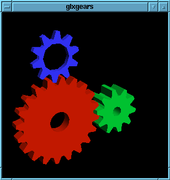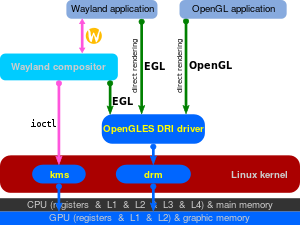|
GLX
GLX (initialism for "OpenGL Extension to the X Window System") is an extension to the X Window System core protocol providing an interface between OpenGL and the X Window System as well as extensions to OpenGL itself. It enables programs wishing to use OpenGL to do so within a window provided by the X Window System. GLX distinguishes two "states": indirect state and direct state. HistorySilicon Graphics developed GLX as part of their effort to support OpenGL in the X Window System. In 1999 SGI released GLX under an open-source license,[2] letting it be incorporated in XFree86 source code version 4.0 in 2000. From there, the code was inherited by the forked X.Org Foundation version of the X Window System X11R6.7.0. On September 19, 2008, SGI created a new SGI FreeB License Version 2.0, which "now mirrors the free X11 license used by X.Org" and "meets the free and open source software community's widely accepted definition of 'free'".[3] In 2009 the Free Software Foundation endorsed the SGI Free License B to be a free-software license, and GLX to be an important free-software graphics project.[4][5] As of 2011, GLX has reached version 1.4. The first internal implementation of GLX API, called GLcore,[6] loaded a version of the software renderer of Mesa inside the X server and rendered the OpenGL commands in a window or pixmap. With the development of DRI, the ability to use hardware accelerated OpenGL through direct contexts was added (primarily used by videogames). In 2006, the popularization of the nested Xgl X server and Compiz compositing window manager lead to the development of Accelerated Indirect GLX (AIGLX). AIGLX brings hardware acceleration to the GLX (indirect context) applications by loading the Mesa DRI driver inside the X server. This method enables the sharing of GL objects between X clients using indirect contexts (they all are in the same address space in the X server) and also between a X client and the compositing window manager, thus accelerating composition. In 2008 the binding in GLcore to the Mesa software renderer was rewritten as a DRI interface module, called
Features GLX consists of three parts:
If client and server are running on the same computer and an accelerated 3D graphics card using a suitable driver is available, the former two components can be bypassed by DRI. In this case, the client application is then allowed to directly access the video hardware through several API layers. Implementations
See also
References
External linksInformation related to GLX |





